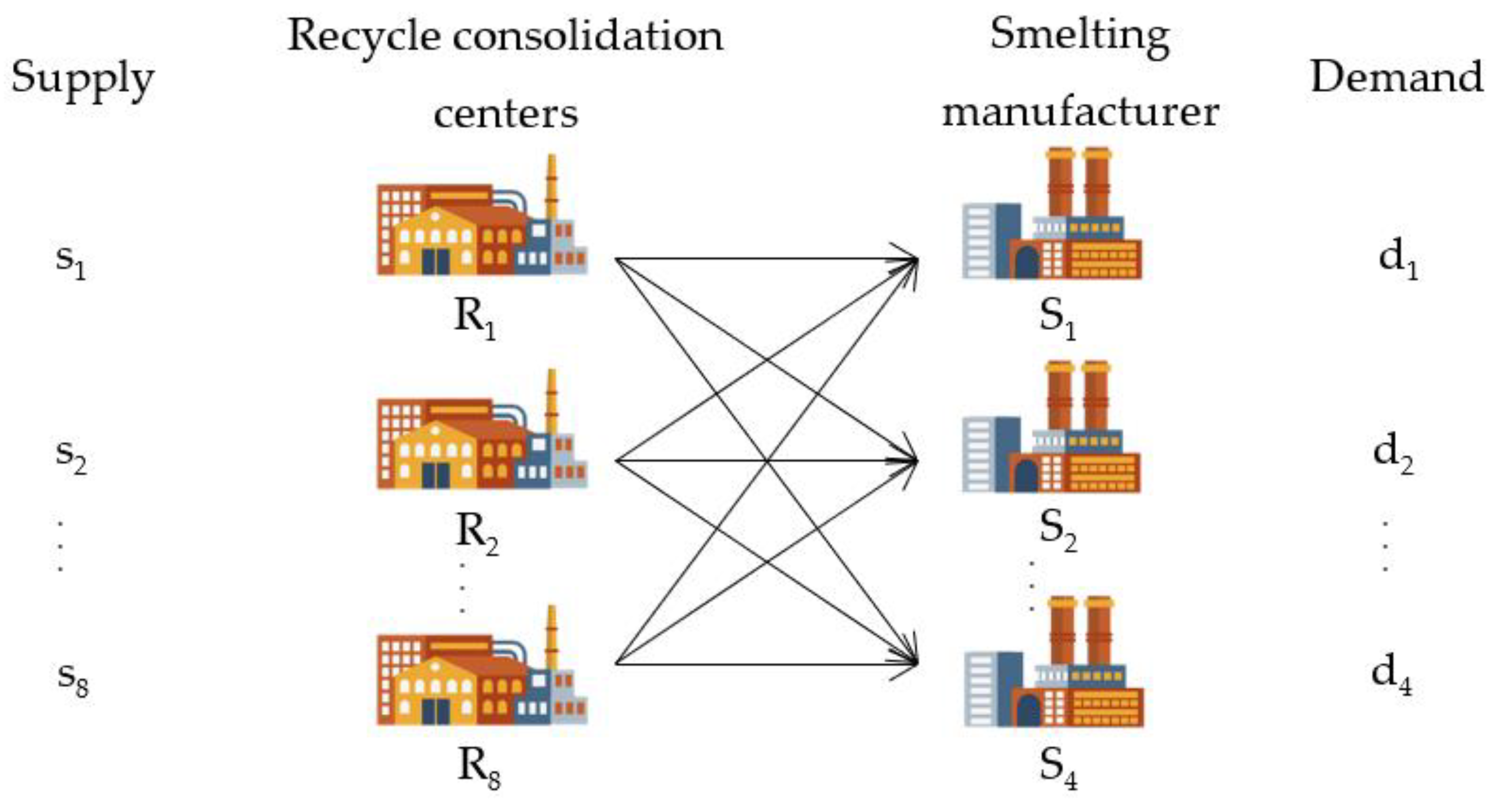Optimal Transportation Cost for End-of-Life Lead- Acid Battery Reverse Logistics: A Case Study of Thailand †
Abstract
:1. Introduction
2. Materials and Methods
2.1. Problem Description
2.2. Mathematic Model
| Minimize | (1) | |
| Subject to | (2) | |
| (3) | ||
| (4) |
3. Result
4. Discussion
Author Contributions
Funding
Conflicts of Interest
References
- Roger, D.S.; Tibben-Lembke, R. Going Backwards: Reverse Logistics Trends and Practices; Reverse Logistics Executive Council: Pittsburgh, PA, USA, 1999; pp. 1–36. [Google Scholar]
- Dat, L.Q.; Linh, D.T.T.; Chou, S.-Y.; Yu, V.F. Optimizing reverse logistics costs for recycling end-of-life electrical and electronic products. Expert Syst. Appl. 2012, 39, 6380–6387. [Google Scholar] [CrossRef]
- Gołębiewski, B.; Teajer, J; Jaros, M.; Winiczenko, R. Modelling of the location of vehicle recycling facilities: A case study in Poland. Resour. Conserv. Recycl. 2013, 80, 10–20. [Google Scholar] [CrossRef]
- Habibi, M.K.K.; Battaïa, O.; Cung, V.D.; Dolgui, A. Collection-disassembly problem in reverse supply chain. Int. J. Prod. Econ. 2017, 183, 334–344. [Google Scholar] [CrossRef]
- Trochu, J.; Chaabane, A.; Ouhimmou, M. Reverse logistics network redesign under uncertainty for wood waste in the CRD industry. Resour. Conserv. Recycl. 2018, 128, 32–47. [Google Scholar] [CrossRef]
- Govindan, K.; Palaniappan, M.; Zhu, Q.; Kannan, D. Analysis of third party reverse logistics provider using interpretive structural modeling. Int. J. Prod. Econ. 2012, 140, 204–211. [Google Scholar] [CrossRef]
- Chiou, C.Y.; Chen, H.C.; Yu, C.T.; Yeh, C.Y. Consideration factors of reverse logistics implementation A case study of Taiwan’s electronics industry. Procedia Soc. Behav. Sci. 2012, 40, 375–381. [Google Scholar] [CrossRef]
- Subulan, K.; Tasan, A.S.; Baykasoglu, A. Designing an environmentally conscious tire closed-loop supply chain network with multiple recovery options using interactive fuzzy goal programming. Appl. Math. Model. 2015, 39, 2661–2702. [Google Scholar] [CrossRef]

| Recycle Consolidation Centers | Smelting Manufacturers | Supply Quantity (Tons/Year) | |||||||
|---|---|---|---|---|---|---|---|---|---|
| S1 | S2 | S3 | S4 | ||||||
| Cost Per Volume | Cost Per Trip | Cost Per Volume | Cost Per Trip | Cost Per Volume | Cost Per Trip | Cost Per Volume | Cost Per Trip | ||
| R1 | 214.7 | 1717.4 | 199.9 | 1599.8 | 291.8 | 2334.0 | 233.3 | 1866.0 | 10,165.2 |
| R2 | 207.5 | 1660.0 | 204.5 | 1636.0 | 300.0 | 2400.0 | 240.8 | 1926.0 | 1016.5 |
| R3 | 215.9 | 1727.0 | 212.7 | 1701.4 | 269.3 | 2154.0 | 216.8 | 1734.2 | 10,165.2 |
| R4 | 220.9 | 1767.0 | 218.4 | 1747.4 | 265.5 | 2124.0 | 207.7 | 1661.2 | 5082.6 |
| R5 | 213.6 | 1709.0 | 200.2 | 1601.6 | 293.6 | 2349.0 | 233.3 | 1866.0 | 1016.5 |
| R6 | 214.4 | 1715.2 | 197.9 | 1582.8 | 297.4 | 2379.0 | 238.9 | 1911.0 | 5082.6 |
| R7 | 250.1 | 2001.0 | 233.3 | 1866.0 | 292.5 | 2340.0 | 229.5 | 1836.0 | 1016.5 |
| R8 | 202.4 | 1618.8 | 207.9 | 1662.8 | 295.9 | 2367.0 | 237.4 | 1899.0 | 25,413.0 |
| sum supply quantity (Tons/year) | 58,958.3 | ||||||||
| sum recycle consolidation centers (Tons/year) | 39,600.0 | ||||||||
| Scenario I (Volume Contract: Thai Baht) | Scenario II (Lump-Sum Contract: Thai Baht) | |
|---|---|---|
| situation 1 (with dummy) | 71,023 | 77,115 |
| situation 2 (without dummy) | 108,773 | 119,248 |
© 2020 by the authors. Licensee MDPI, Basel, Switzerland. This article is an open access article distributed under the terms and conditions of the Creative Commons Attribution (CC BY) license (http://creativecommons.org/licenses/by/4.0/).
Share and Cite
Siriruttanaruk, S.; Sumrit, D. Optimal Transportation Cost for End-of-Life Lead- Acid Battery Reverse Logistics: A Case Study of Thailand. Proceedings 2019, 39, 9. https://doi.org/10.3390/proceedings2019039009
Siriruttanaruk S, Sumrit D. Optimal Transportation Cost for End-of-Life Lead- Acid Battery Reverse Logistics: A Case Study of Thailand. Proceedings. 2019; 39(1):9. https://doi.org/10.3390/proceedings2019039009
Chicago/Turabian StyleSiriruttanaruk, Supitcha, and Detcharat Sumrit. 2019. "Optimal Transportation Cost for End-of-Life Lead- Acid Battery Reverse Logistics: A Case Study of Thailand" Proceedings 39, no. 1: 9. https://doi.org/10.3390/proceedings2019039009
APA StyleSiriruttanaruk, S., & Sumrit, D. (2019). Optimal Transportation Cost for End-of-Life Lead- Acid Battery Reverse Logistics: A Case Study of Thailand. Proceedings, 39(1), 9. https://doi.org/10.3390/proceedings2019039009




